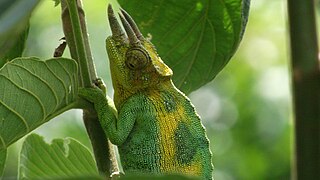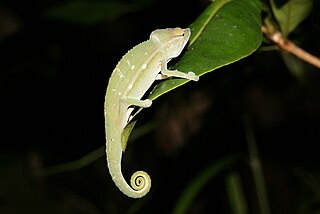
Chamaeleo is a genus of chameleons in the family Chamaeleonidae. Most species of the genus Chamaeleo are found in sub-Saharan Africa, but a few species are also present in northern Africa, southern Europe, and southern Asia east to India and Sri Lanka.

Jackson's chameleon, also known commonly as Jackson's horned chameleon, the three-horned chameleon, and the Kikuyu three-horned chameleon, is a species of chameleon, a lizard in the family Chamaeleonidae. The species is native to East Africa, and introduced to Hawaii, Florida, and California. There are three recognized subspecies.

Trioceros johnstoni, known commonly as Johnston's chameleon, Johnston's three-horned chameleon, or the Ruwenzori three-horned chameleon, is a species of chameleon, a lizard in the family Chamaeleonidae. It is endemic to highlands in the Albertine Rift in central Africa. It reaches up to 30 cm (12 in) in total length and only the adult male has three horns; females are hornless.

Trioceros is a genus of lizards in the family Chamaeleonidae, the chameleons, native to lowlands and highlands in the African mainland, ranging from Ethiopia south to Mozambique and west as far as Ghana. Trioceros was considered a subgenus of the genus Chamaeleo until 2009, when it was elevated to full genus level.

Trioceros melleri, with the common names Meller's chameleon and giant one-horned chameleon, is the largest species of chameleon from the African mainland.

The flap-necked chameleon is a species of arboreal chameleon, a lizard in the family Chamaeleonidae. The species is native to sub-Saharan Africa. There are eight recognized subspecies, including the nominotypical subspecies.
The St. Thomas beaked snake is a species of snake in the family Typhlopidae. The species is native to the Gulf of Guinea off the western coast of Central Africa.
Kinyongia carpenteri, commonly called Carpenter's chameleon or the helmeted chameleon, is a species of chameleon, a lizard in the family Chamaeleonidae. The species is native to central Africa.

Chamaeleoninae is the nominotypical subfamily of chameleons. The Family Chamaeleonidae was divided into two subfamilies, Brookesiinae and Chamaeleoninae, by Klaver and Böhme in 1986. Since its erection in 1986, however, the validity of this subfamily designation has been the subject of much debate, although most phylogenetic studies support the notion that the pygmy chameleons of the subfamily Brookesiinae are not a monophyletic group. While some authorities have previously preferred to use the subfamilial classification on the basis of the absence of evidence principal, these authorities later abandoned this subfamilial division, no longer recognizing any subfamilies with the family Chamaeleonidae. In 2015, however, Glaw reworked the subfamilial division by placing only the genera Brookesia and Palleon within the Brookesiinae subfamily, with all other genera being placed in Chamaeleoninae.

Trioceros hoehnelii, commonly known as von Höhnel's chameleon, the helmeted chameleon, and the high-casqued chameleon, is a species of chameleon, a lizard in the family Chamaeleonidae. The species is native to eastern Africa.

The crested chameleon, also known as the sail backed chameleon, is a species of chameleon native to forests and semi-open wooded habitats in Central Africa.

Owen's chameleon, also commonly known as Owen's three-horned chameleon, is a species of lizard in the family Chamaeleonidae. The species is native to forests in central Africa. Named after British naval officer and explorer William Fitzwilliam Owen, it was first described in 1831 by the naturalist John Edward Gray, and is the type species of the genus Trioceros.

The four-horned chameleon is a species of chameleon, a lizard in the family Chamaeleonidae. The species is native to highland areas in western Cameroon and southeastern Nigeria.

The ugly worm lizard is a species of amphisbaenian in the family Amphisbaenidae. The species is native to West Africa.

Calumma guillaumeti is a species of chameleon, a lizard in the family Chamaeleonidae. The species is endemic to Madagascar.
Trioceros chapini, also known commonly as Chapin's chameleon, the gray chameleon, and the grey chameleon, is a species of lizard in the family Chamaeleonidae. The species is native to Central Africa.

Trioceros ellioti, also known commonly as Elliot's chameleon, Elliot's groove-throated chameleon, and the montane side-striped chameleon, is a species of lizard in the family Chamaeleonidae. The species is indigenous to Africa.
Trioceros fuelleborni, also known commonly as the flapjack chameleon, the Ngosi Volcano chameleon, and the Poroto three-horned chameleon, is a species of lizard in the family Chamaeleonidae. The species is endemic to Tanzania.

Trioceros goetzei, also known commonly as Goetze's chameleon, Goetze's whistling chameleon, and the Ilolo chameleon, is a species of lizard in the family Chamaeleonidae. The species is native to eastern Africa. There are two recognized subspecies.
Trioceros harennae, also known commonly as the Harenna hornless chameleon, is a species of lizard in the family Chamaeleonidae. The species is endemic to Ethiopia. There are two recognized subspecies.
















